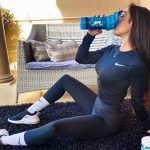
In part one of this we looked at weight training, and why it’s so beneficial for women to do it, so if you missed it, check out Women and Weight Training- Part 1 for some great information and tips.
Yes weight training can do so much for you in such a positive light, but without the proper nutrition and eating habits you may never progress and see that big difference that you have been longing to see. Here we deal with a few simple nutrition strategies to help get you started, and guide you in achieving your goal of losing fat and building and toning your muscles. Remember, to change and improve your body you must be consistent with your exercising and your eating. You must make sure to do some sort of exercise and be active.
Aspects such as, how many meals to eat, what exactly to eat, how many calories to eat and the reasons behind it all, will be dealt with. You should try to keep things as simple as possible, especially with regards to nutrition, as if it’s too complicated it can really put you off.
“Fact: Nutrition is always the limiting factor in body transformation. If a client doesn’t change their nutrition, all the effort in the gym is largely wasted.” ~ Dr. John Berardi
So where to start?
Firstly you need to have the right mind set and attitude. You need to decide what it is you want to achieve and visualise your goal, and your ideal body and stick with it. You need to realise that you’re going to need to be disciplined and prepared, and at times it will require sacrifices.
How many meals should you be eating?
The general ideal way to lose fat, or gain muscle is to eat small but frequent meals. This is not the only way though. So anywhere between four and six meals/snacks a day. A meal every three to four hours. This has been covered in a previous article, Healthy eating – How many meals a day?
What should you be eating?
The thought of having to eat four or more meals a day can be quite daunting and can lead to the question, ‘what on earth do I eat for every one of those meals?’ Well the good news is that there are quite a lot of different foods you can choose from and another plus is, with regular exercise your appetite should increase.
Variety is key so that you don’t get bored and end up eating the same thing every day. Although, some people find it easier and simpler to stick to the same foods day in and day out. Whatever works for YOU.
The different macro nutrients and foods that will make up your diet:
- Always think PROTEIN. This should be your main focus, and each of your meals must contain some form of protein. The reason for this is so that you can constantly supply your body with amino acids necessary for muscle repair and growth, as well as many other bodily functions ( such as hair growth, skin rejuvenation etc). Some protein food sources include: Chicken, eggs, red meat, fish, Greek yoghurt, cottage cheese, milk, lentils, quinoa, tofu, nuts.
Your protein content should stay relatively consistent, where as your carbohydrates and fat can be manipulated more, depending on if you’re trying losing fat or to gain weight.
- Next up, vegetables. Try to include a bowl of vegetables with at least three of your meals in a day. Some good vegetables can include: broccoli, cauliflower, green beans, carrots, tomatoes, spinach, peppers, peas, onions etc. Vegetables are packed with fibre, vitamins and minerals, all essential for our well being. Fiber is so good for helping our digestive system, cleaning inside our stomach, and aiding in making us feel full.
- Fruit. If you read a few magazine articles here and there you can find many people saying you should rather avoid fruit or minimize it as most fruits contain a lot of sugar and fructose. It’s a good idea to include some fruit in your diet, especially with your breakfast or make sure to eat a piece of fruit just before one of your meals, as they offer many vitamins and minerals naturally. For instance for your second meal of the day you can have an apple/pear/orange/grapefruit first then continue to have a chicken salad for example. Fruit also contains fiber which will help keep us full.
- Carbohydrates. With exercise and especially weigh training, you may find yourself needing a lot of energy. Good carbohydrates can provide you with the fuel you will need to get through your daily training. Try to include some carbohydrates at breakfast and before and after you train to provide you with enough energy and recovery. Some good carbohydrate sources include: Oats, rice, potatoes and sweet potatoes, quinoa, lentils, cous cous etc. Include a portion of carbohydrates with two or three of the meals, but again, personal preference can come into play here. There are a lot of people who don’t eat much before they train as they feel too full and it causes them to feel like throwing up. So if you are one of those people, by all means manipulate it to suit your needs.
- Fats. It’s a long time myth that eating fats cause you to get fat. This is really not the case. Fats play an important role within our bodies, regulating our hormones and inducing the production of some hormones. So to completely eliminate them from your diet would not be a wise decision. Some good fats include: olive oil, nuts, peanut butter, avocados etc. It would be a good idea to include some of these fats at breakfast and in your last meals of the day when carbohydrates are low.
So far we have established that you will:
- Be eating four to six meals in a day,
- With each meal containing some form of protein,
- With a portion of vegetables included in at least three of the meals.
- Eat a portion of fruit at breakfast and/or before one other meal.
- Include a portion of carbohydrates in your two meals before and after training and at breakfast.
- Include some good fats with your last two meals of the day.
How many calories and grams should you eat?
In the spirit of keeping things simple we will keep away from saying you should be eating x amount of grams of this food and that food. There are some articles which state, to calculate how many calories you should be eating, multiply your bodyweight by 14 or 15. This method is slightly vague and we should rather go according to portions as that former way can get quite complicated, especially for someone who doesn’t know much about calories.
One very important note which you need to be aware of, is that different people have different needs. Basically the amount of calories and nutrients YOUR body may need to lose fat could be totally different to someone else.
The exact amounts of calories required by you depend on many things, such as your weight, your body fat, the amount of activity you do in a day, the amount of rest you get and need etc. So while each of us needs to find out how much is sufficient for us, there are still basic principles which can be used to get started.
For vegetables you don’t have to worry too much as more is better than less in this case. So for these you can just chop some vegetables up into a medium sized bowl for each meal. For your protein, use your fist as a comparison. So for foods like chicken and fish and mince, one portion should be just bigger than your fist. For carbohydrates you can use ¾ of a cup to 1 cup as a one portion. Lastly for fats it’s a bit different. Use one teaspoon as one portion. For instance a teaspoon of olive oil, peanut butter or avocado.
So once you put all these portions together with each of your meals, you will start to see how your body responds and from there you can manipulate and change it as you need, decreasing or increasing what you need.
These portion sizes are relatively small, but should be adequate for the average woman. Depending on your weight and body fat you can adjust them to suit your needs. This is all just a guideline to help you get started and to see how you need to eat to maximise your results, be fit and healthy and achieve a great body 🙂
Here is another great article about the benefits of weight training for women and why females should want to gain muscle. If you are still not convinced check these reasons out! 10 reasons why females should be obsessed with gaining muscle














